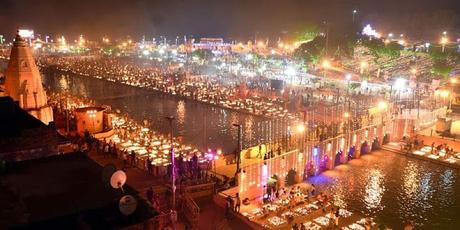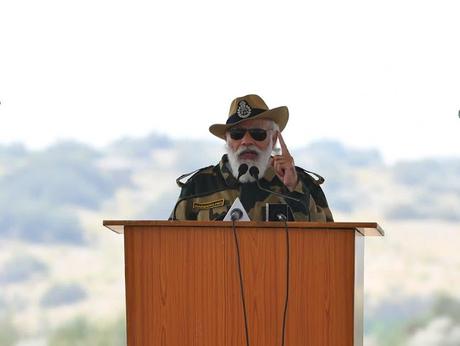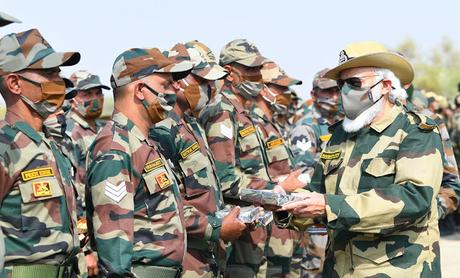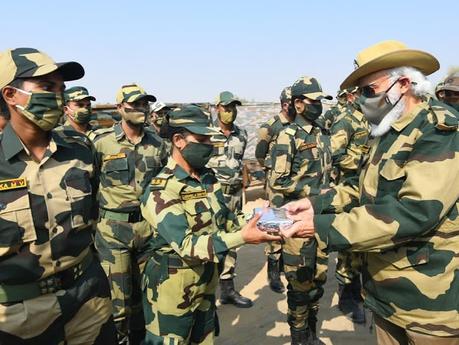The festival of lights ‘Deepavali’ was grandly celebrated across the Nation and many parts of the globe.
Deepavali generally would see lakhs of people traveling back to their hometowns from their workplace for celebrating the festival with their near and dear. Our Prime Minister Shri Narendra Modiji has set a great example in celebrations too. Prime Minister Shri Modiji reached Longewala post at Rajasthan border this morning to celebrate Diwali with soldiers. PM Modi has been spending the Deepavali day with soldiers since 2014, the year he first became came to power. Chief of Defence Staff General Bipin Rawat, Army Chief General MM Naravane and Border Security Force (BSF) DG Rakesh Asthana are also accompanying the PM.

The great gesture of our PM in being with and celebrating Diwali with our armed forces makes us all feel happy and proud.We also learn some history, which was not part of our school curriculum .. .... but why ?

Longewala is a border town in the Thar Desert in the western part of Jaisalmer district, in the state of Rajasthan. It is very close to the border with Pakistan and is most notable as the location of the Battle of Longewala during the Indo-Pakistani War of 1971.
The main thrust of the Indian Army during the 1971 war was directed towards the eastern theatre, with the western sector envisaged as a holding operation to prevent the Pakistan Army from achieving any success that would allow the President of Pakistan, Yahya Khan, any bargaining tool to trade against the captured territories in the east. By the last week of Nov 1971, the Indian Army had launched offensive manoeuvres at Atgram against Pakistani border posts and communications centres along the eastern border. The Mukti Bahini also launched an offensive on Jessore at this time. It was clear to Islamabad by this time that open conflict was inevitable, and that East Pakistan was indefensible in the long run. Yahya Khan chose at this point to try to protect Pakistan's integrity and to hold India by Ayub Khan's strategy – "The defence of East Pakistan lies in the West".
The Battle of Longewala (4–7 December 1971) was one of the first major engagements in the western sector during the Indo-Pakistani War of 1971, fought between assaulting Pakistani forces and Indian defenders at the Indian border post of Longewala, in the Thar Desert of Rajasthan state in India.The battle was fought between 120 Indian soldiers accompanied by 4 Hunter fighter aircraft and 2000-3000 Pakistani soldiers accompanied by 30-40 tanks.

The Pakistani commanders made several blunders, including a failure of their strategic intelligence to foresee availability of Indian strike aircraft in the Longewala area, exercising operational mobility with little or no route reconnaissance, and conducting a tactical frontal assault with no engineer reconnaissance. This led to the Pakistani brigade group being left extremely vulnerable to air attack, vehicles becoming bogged in terrain not suitable for the movement of armoured vehicles.
Although massively outnumbering the Indian defenders, and having surrounded them, the Pakistani troops were unable to advance over open terrain on a full-moon night, under small arms and mortar fire from the outpost. This encouraged the Indians not to give up their strong defensive position, frustrating the Pakistani commanders. As dawn arrived, the Pakistan forces had still not taken the post, and were now having to do so in full daylight. In the morning, the Indian Air Force was able to direct some HAL HF-24 Maruts and Hawker Hunter aircraft to assist the post; they were not outfitted with night vision equipment, and so were delayed from conducting combat missions until dawn. The Indian aircraft attacked the Pakistani ground troops with the 16 Matra T-10 rockets and 30 mm cannon fire on each aircraft. Without support from the Pakistan Air Force, which was busy elsewhere, the tanks and other armoured vehicles were easy targets for the IAF's Hunters. By noon the next day, the assault ended completely, having cost Pakistan 22 tanks claimed destroyed by aircraft fire, 12 by ground anti-tank fire, and some captured after being abandoned, with a total of 100 vehicles claimed to have been destroyed or damaged in the desert around the post.
The battle of Longewala saw heavy Pakistani losses and few Indian casualties. Since the Indians were able to use the defenders' advantage, they managed to inflict heavy losses on the Pakistanis. Indian casualties in the battle were two soldiers along with one of their jeep mounted recoilless rifles knocked out. Pakistani losses were 200 soldiers killed; loss of 34 tanks destroyed or abandoned, and lost 500 additional vehicles

Thus a place of historic importance Longewala – should it not be part of our History books ! . .. .. earlier, in the day, PM Modi tweeted his greeting to the nation and wished for the festival to bring ‘brightness and happiness’ in the lives of people. “Wishing everyone a Happy Diwali! May this festival further brightness and happiness. May everyone be prosperous and healthy,” PM Modi tweeted. On Friday, the PM shared a clipping from his monthly radio programme Mann Ki Baat, delivered last on October 25, in which he urged every citizen to light a diya as a as a salute to soldiers who “fearlessly protect our nation”.In 2019, PM Modi visited the “Hall of Fame” in Rajouri and the Pathankot Airbase. In 2018, he visited Kedarnathand and inspected a military post on the India-China border and in 2017, he visited Gurez sector of north Kashmir. He spent his Diwali with the Indo-Tibetan Border Police in Himachal Pradesh in 2016 and in 2015, he visited the Punjab border.


A great piece of historic significance remembered and we are reading about this because of the visit of our Honourable Prime Minister. Jai Jawan, Jai Hind, Happy Deepavali.
With regards – S. Sampathkumar
14.11.2020.

